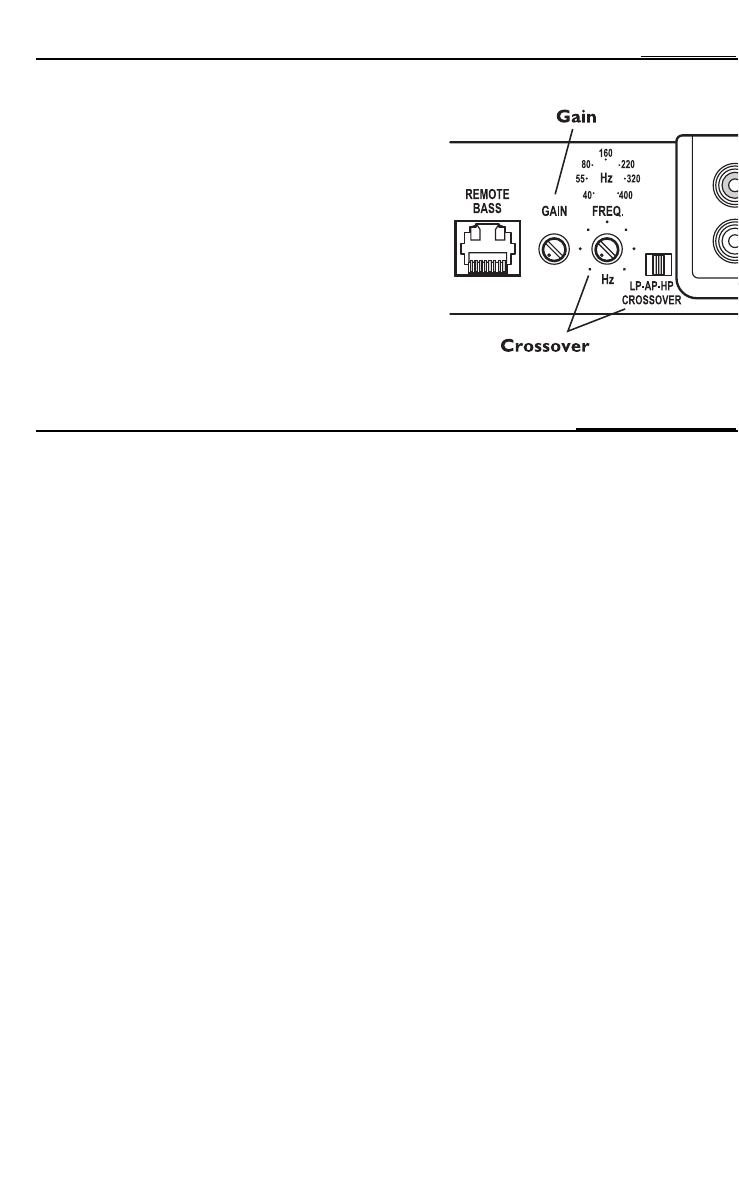
ADJUSTING CROSSOVER FREQUENCY
Placing the switch in the HP position sets the amplifier to
the High Pass mode, enabling frequencies above the cut-off
point to pass, adjustable between 40-400Hz.
Placing the switch in the AP position sets the amplifier to the
All Pass mode, preventing any crossover adjustment, allowing
all frequencies to pass.
Placing the switch in the LP position sets the amplifier to the
Low Pass mode, enabling frequencies below the cut-off point
to pass, adjustable between 40-400Hz.
Turn the crossover adjustment knob all the way down.With
the system playing, turn the crossover adjustment knob up
slowly until the desired crossover point is achieved.
9
OPERATION
TROUBLESHOOTING
NOTE:If you are having problems after installation follow the Troubleshooting procedures below.
Procedure 1: Check Amplifier for proper connections.
Verify that POWER light (light on Remote Punch Bass) is on. If POWER light is on skip to Step 2, if
not continue.
1. Check in-line fuse on battery positive cable. Replace if necessary.
2. Check fuse(s) on amplifier. Replace if necessary.
3. Verify that Ground connection is connected to clean metal on the vehicle’s chassis. Repair/replace if
necessary.
4. Verify there is 10.5 - 15.5 Volts present at the positive battery and remote turn-on cable.Verify quality
connections for both cables at amplifier, stereo, and battery/fuseholder.Repair/replace if necessary.
Procedure 2: Check Amplifier for audio output.
1. Verify good RCA input connections at stereo and amplifier.Check entire length of cables for kinks,
splices, etc.Test RCA inputs for AC volts with stereo on. Repair/replace if necessary.
2. Disconnect RCA input from amplifier.Connect RCA input from test stereo directly to amplifier input.
Procedure 3: Check Amplifier if you experience Turn-on Pop.
1. Disconnect input signal to amplifier and turn amplifier on and off.
2. If the noise is eliminated, connect the REM lead of amplifier to source unit with a delay turn-on
module.
OR
1. Use a different 12 Volt source for REM lead of amplifier (i.e. battery direct).
2. If the noise is eliminated, use a relay to isolate the amplifier from noisy turn-on output.
Procedure 4: Check Amplifier if you experience excess Engine Noise.
1. Route all signal carrying wires (RCA, Speaker cables) away from power and ground wires.
OR
2. Bypass any and all electrical components between the stereo and the amplifier(s). Connect stereo
directly to input of amplifier. If noise goes away the unit being bypassed is the cause of the noise.
Continued.....


















